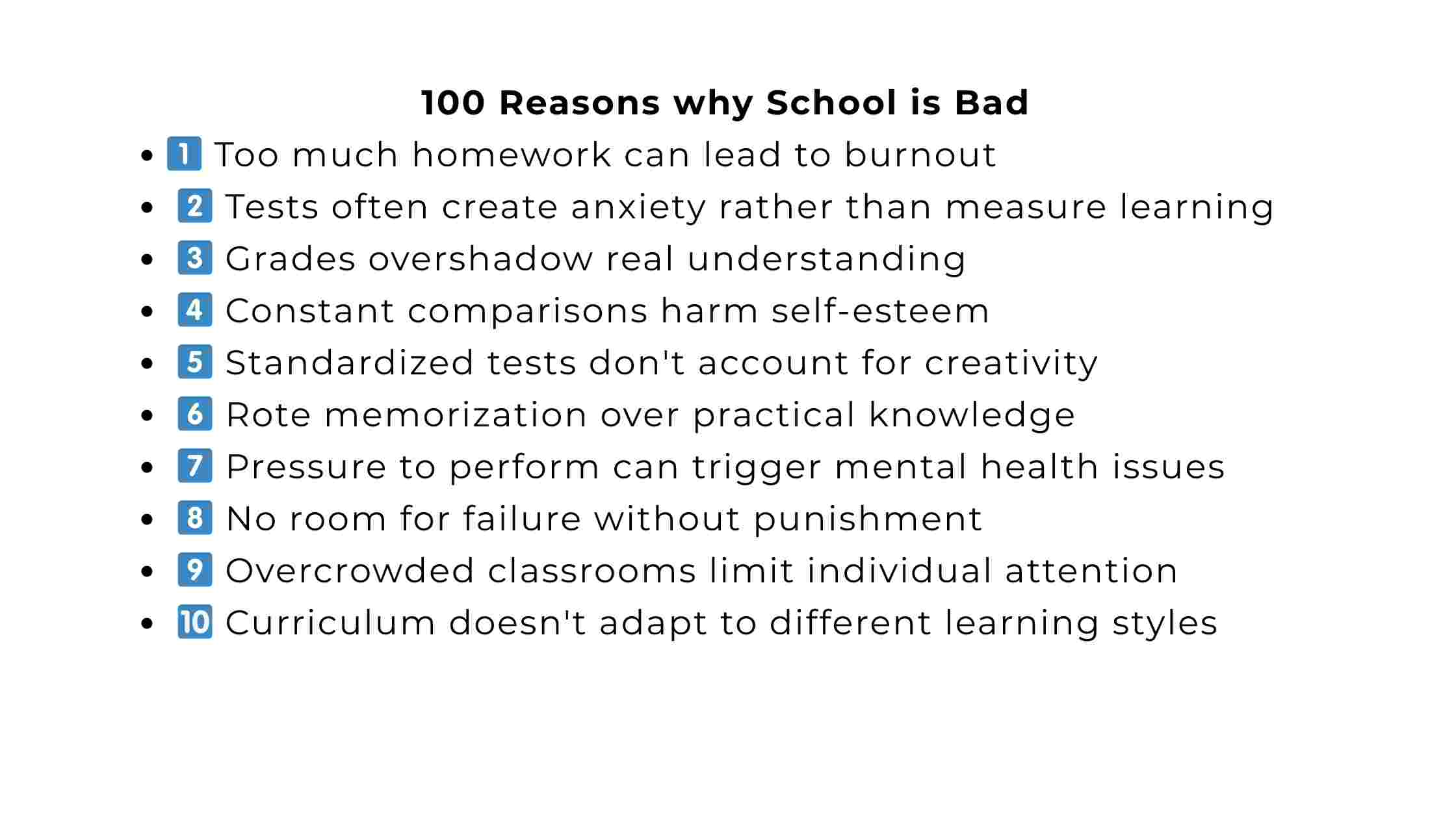100 Reasons why School is Bad

School is meant to be a place for growth, learning, and personal development — but the traditional school system isn’t perfect. Many students face emotional, social, and academic pressures that can make school feel like a struggle rather than a supportive environment.
There are more than 10 reasons, more than 20, and even more than 50 reasons why school is bad for students, especially high school and college. We have written another blog post on why school is a waste of time.
Below are 100 Reasons Why School Can Be Bad
From outdated teaching methods to mental health impacts, the system often falls short of meeting individual needs.
Academic Pressure and Stress
- 1️⃣ Too much homework can lead to burnout
- 2️⃣ Tests often create anxiety rather than measure learning
- 3️⃣ Grades overshadow real understanding
- 4️⃣ Constant comparisons harm self-esteem
- 5️⃣ Standardized tests don’t account for creativity
- 6️⃣ Rote memorization over practical knowledge
- 7️⃣ Pressure to perform can trigger mental health issues
- 8️⃣ No room for failure without punishment
- 9️⃣ Overcrowded classrooms limit individual attention
- 🔟 Curriculum doesn’t adapt to different learning styles
- 1️⃣1️⃣ Lack of real-world life skills
- 1️⃣2️⃣ Teaching to the test rather than for understanding
- 1️⃣3️⃣ Slow learners often get left behind
- 1️⃣4️⃣ Fast learners get bored and disengaged
- 1️⃣5️⃣ Strict grading kills curiosity
- 1️⃣6️⃣ Short recess times limit physical and social growth
- 1️⃣7️⃣ Overemphasis on academic success over personal growth
- 1️⃣8️⃣ Too many rules, not enough creative freedom
- 1️⃣9️⃣ Unnecessary subjects forced on students
- 2️⃣0️⃣ Lack of autonomy in choosing what to learn
Social Environment Issues
- 2️⃣1️⃣ Bullying and peer pressure
- 2️⃣2️⃣ Exclusion and social isolation
- 2️⃣3️⃣ Toxic cliques and group divides
- 2️⃣4️⃣ Popularity contests over kindness
- 2️⃣5️⃣ Body shaming and appearance judgment
- 2️⃣6️⃣ Gender stereotypes reinforced by school culture
- 2️⃣7️⃣ Lack of mental health support
- 2️⃣8️⃣ Competition over collaboration
- 2️⃣9️⃣ Teacher favoritism can damage confidence
- 3️⃣0️⃣ Limited diversity acceptance
- 3️⃣1️⃣ Cultural insensitivity in curriculum
- 3️⃣2️⃣ Negative peer influence
- 3️⃣3️⃣ Cyberbullying via school networks
- 3️⃣4️⃣ Unrealistic behavioral expectations
- 3️⃣5️⃣ Students labeled early and unfairly
- 3️⃣6️⃣ Victim-blaming in bullying situations
- 3️⃣7️⃣ Cliques prevent genuine friendships
- 3️⃣8️⃣ Stress from social status battles
- 3️⃣9️⃣ Lack of freedom to express individuality
- 4️⃣0️⃣ Social anxiety made worse by public speaking pressure
System and Structural Flaws
- 4️⃣1️⃣ Underpaid teachers
- 4️⃣2️⃣ Outdated facilities and equipment
- 4️⃣3️⃣ Lack of modern teaching tools
- 4️⃣4️⃣ Rigid bell schedules stifle creativity
- 4️⃣5️⃣ One-size-fits-all education model
- 4️⃣6️⃣ Limited funding for important programs
- 4️⃣7️⃣ Over-reliance on textbooks over experiences
- 4️⃣8️⃣ Politics influencing education decisions
- 4️⃣9️⃣ School rankings add unnecessary pressure
- 5️⃣0️⃣ Little focus on emotional intelligence
- 5️⃣1️⃣ Exams don’t reflect real-world skills
- 5️⃣2️⃣ Limited career guidance
- 5️⃣3️⃣ Lack of teacher training in handling diverse learners
- 5️⃣4️⃣ Zero tolerance policies hurt more than help
- 5️⃣5️⃣ Too much paperwork for teachers
- 5️⃣6️⃣ Limited flexibility for special needs students
- 5️⃣7️⃣ Inconsistent disciplinary measures
- 5️⃣8️⃣ Little encouragement for entrepreneurship
- 5️⃣9️⃣ No focus on mental health literacy
- 6️⃣0️⃣ Grades valued over creativity and original thinking
Mental and Emotional Health Impacts
- 6️⃣1️⃣ Test anxiety leads to underperformance
- 6️⃣2️⃣ Chronic sleep deprivation from early start times
- 6️⃣3️⃣ High-stakes exams cause extreme stress
- 6️⃣4️⃣ Fear of failure creates perfectionism
- 6️⃣5️⃣ Constant pressure to compete with peers
- 6️⃣6️⃣ No lessons on emotional regulation
- 6️⃣7️⃣ Lack of safe spaces to discuss feelings
- 6️⃣8️⃣ Stress-related health issues
- 6️⃣9️⃣ Emotional disconnection from learning
- 7️⃣0️⃣ Boredom leads to apathy and depression
- 7️⃣1️⃣ Loneliness in crowded classrooms
- 7️⃣2️⃣ Self-worth linked to grades
- 7️⃣3️⃣ Low motivation caused by rigid systems
- 7️⃣4️⃣ Limited outlets for self-expression
- 7️⃣5️⃣ Punishment-based discipline rather than guidance
- 7️⃣6️⃣ No room for mistakes without judgment
- 7️⃣7️⃣ Mental health issues go unnoticed
- 7️⃣8️⃣ Overwhelming extracurricular demands
- 7️⃣9️⃣ Little emphasis on mindfulness or self-care
- 8️⃣0️⃣ Neglect of emotional development in favor of academic results
Real-World Disconnect
- 8️⃣1️⃣ Little financial literacy taught
- 8️⃣2️⃣ Limited teaching of soft skills like communication
- 8️⃣3️⃣ Too little focus on entrepreneurship
- 8️⃣4️⃣ Doesn’t teach negotiation or conflict resolution
- 8️⃣5️⃣ Rarely teaches time management properly
- 8️⃣6️⃣ Fails to teach critical life skills like cooking, taxes, or insurance
- 8️⃣7️⃣ Limited global awareness in some curriculums
- 8️⃣8️⃣ Doesn’t prepare students for real-life challenges
- 8️⃣9️⃣ Focus on memorization over problem-solving
- 9️⃣0️⃣ Obsolete knowledge in some subjects
- 9️⃣1️⃣ Little exposure to hands-on learning
- 9️⃣2️⃣ Ignores entrepreneurship as a career path
- 9️⃣3️⃣ Limited leadership development opportunities
- 9️⃣4️⃣ Overemphasis on facts rather than application
- 9️⃣5️⃣ Doesn’t prepare students for digital-age careers
- 9️⃣6️⃣ Rarely teaches emotional intelligence in work settings
- 9️⃣7️⃣ Doesn’t teach how to manage money effectively
- 9️⃣8️⃣ Career counseling is often weak or absent
- 9️⃣9️⃣ No focus on personal branding or self-promotion
- 💯 Learning stops after school — real education begins in life
Conclusion
While schools play a role in shaping young minds, these 100 reasons highlight why many students feel the system is flawed. Education should evolve into something more flexible, creative, and emotionally supportive, helping students become both smart and well-rounded human beings.
Cite this article
You can copy and paste your preferred citation format below.
Martin, L. & Arquette, E.. (2025, April 20). 100 Reasons why School is Bad. Coursepivot.com. https://coursepivot.com/blog/100-reasons-why-school-is-bad/



